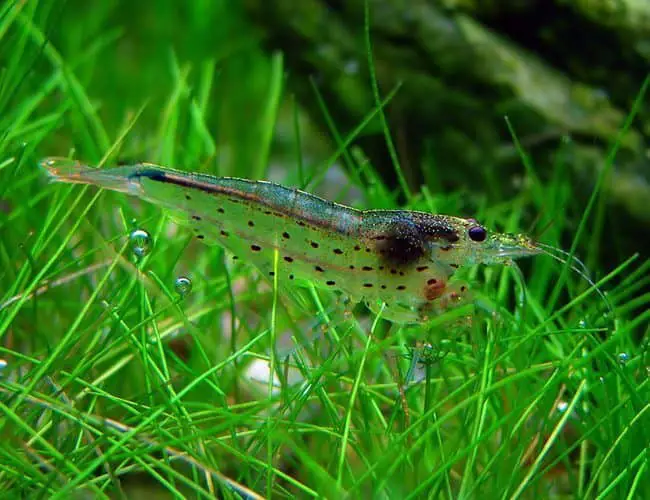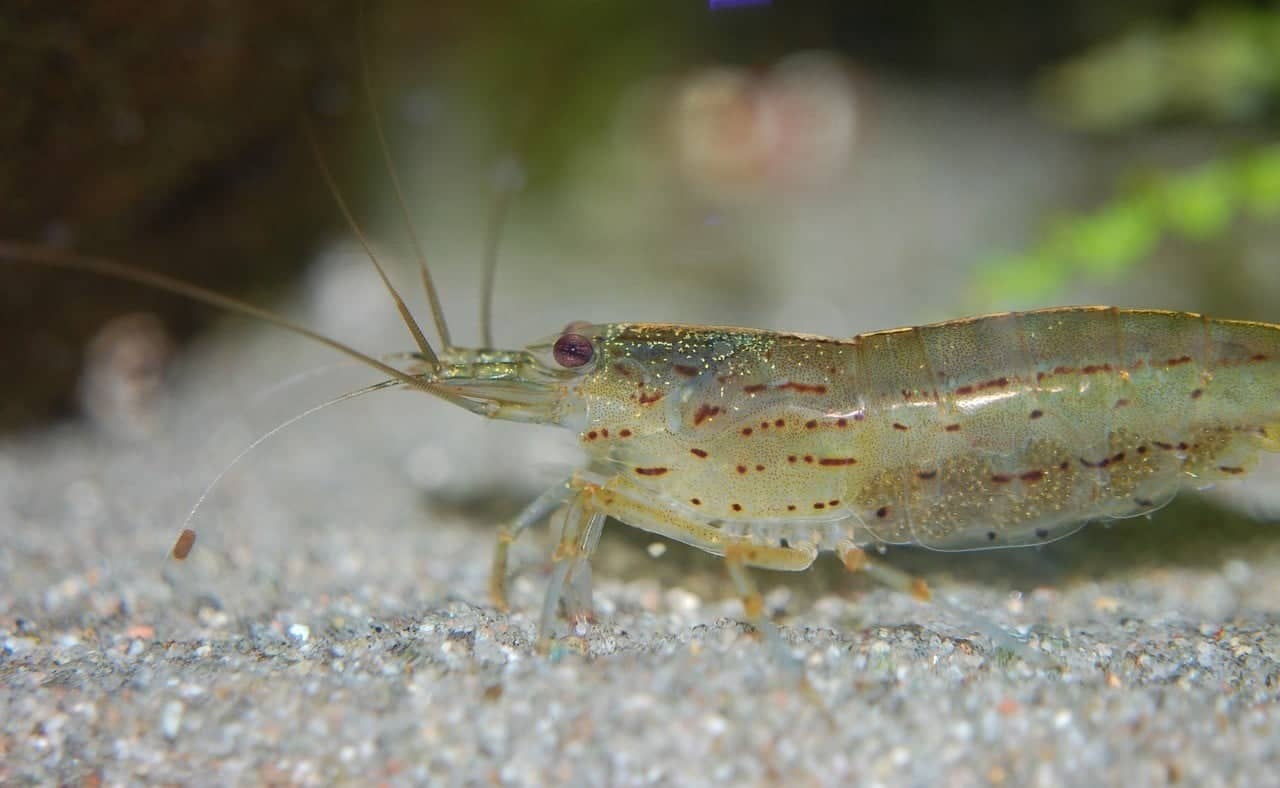Yes. Amano shrimp Eat Algae and better algae eater among other shrimps that will help you get algae under control. Keeping a shrimp in the tank is considered one of the effortless and most efficient ways of controlling algae problems.
Algae is a common problem any Aquarist face. They grow even if you keep a clean tank and need to be removed with chemicals or other solutions. The most popular solution to control algae problems is to keep an algae eater in your tank. Shrimps are known as good algae eaters.

About Amano Shrimps
Jump To
- 1 About Amano Shrimps
- 2 Do Amano Shrimp Eat Algae?
- 3 Do Amano Shrimp Eat Hair Algae?
- 4 Do A Shrimp Eat Algae Wafers?
- 5 Do A Shrimp Eat Brown Algae?
- 6 Do Amano Shrimp Eat Black Beard Algae?
- 7 Do Amano Shrimp Clean Green Hair Algae?
- 8 Do Amano Shrimps Eat Blue-Green Algae?
- 9 Do Amano Shrimp Eat Green Algae?
- 10 Does Amano Shrimp Eat Brown Algae?
- 11 What Algae Does Amanos Shrimp Eat?
- 12 Will Amano Shrimps Clean Algae Off Glass?
- 13 Do Amano Shrimps Eat Diatoms?
- 14 Do Shrimps Clean Fish Tanks?
- 15 Summary
Amano shrimp (Caridina multidentata) is a translucent light grey colored small shrimp that will grow to 2 inches long. The life span of Amano shrimp is about three years. They sometimes die when changing their environment because of the change in water parameters and stress from transporting.
The suitable water temperature level is 72 – 78 Degrees Fahrenheit, and the ph level is 7.2 – 7.5. They can blend into both open and planted fish tanks and do well with any other fish, including their own kind. Predators, however, will eat Amano shrimps. So, if you put Amano shrimps in your tank, avoid including predator fish in your community tank.
It would be best if you were careful with medications, Ammonia spikes, high Nitrate levels, and most importantly, avoid copper to keep Amano shrimps healthy and happy. To get the best out of Amano shrimp, you need to put at least one shrimp for every 10 liters of water. They cannot reproduce in freshwater tanks.
So, buying may be the only option if you don’t have access to seawater. They are not expensive; you can buy Amano shrimps for about $3 from a local pet store. Amano shrimp are known as one of the best algae eaters which can eat almost any algae. Other than algae, they eat worms, fish, snails, other dead shrimps, pellets, flakes, algae wafers, and living plants. To get them hungry, you have to refrain from feeding them food to go after the algae. Otherwise, they will eat the food you provide and do nothing but swim in the tank.

Do Amano Shrimp Eat Algae?
Yes. Amano shrimp are considered the best algae eater of all the shrimp species. However, you have to keep them hungry all the time. Do not feed them with flakes and pellets, and you will get an excellent algae eater in your tank.
Do Amano Shrimp Eat Hair Algae?
Yes. this shrimp can eat hair algae from your tank. But if there is excess food available in the tank they will avoid eating hair algae and Start eating excess food available.
Do A Shrimp Eat Algae Wafers?
Yes. They eat algae wafers. However, you should put it only if you have a tank that is “too clean”. For tanks with algae, you should rarely feed Amano Shrimps.
Do A Shrimp Eat Brown Algae?
Yes. Amano shrimp can eat brown algae. But, they cannot clean the glass in your tank. They do not have the necessary tools for this job. So, Amano shrimp cannot clean the spots of brown algae.
Do Amano Shrimp Eat Black Beard Algae?
Yes. Black beard algae usually grow in tanks with strong lights. It is one of the hardiest algae out there and is very hard to kill. Very few fish and shrimp can consume it. Amano shrimp is the only shrimp that can eat black beard algae.
Do Amano Shrimp Clean Green Hair Algae?
Yes. They can eat green hair algae.
Do Amano Shrimps Eat Blue-Green Algae?
No. Blue-Green Algae is actually not true algae but rather cyanobacteria. No fish or shrimp will eat living blue-green algae. Cyano produces a mild toxin that makes it unpleasant for critters to eat it. You have to kill these bacteria with antibiotics. Then they will eat the dead leftover blue-green algae.
Do Amano Shrimp Eat Green Algae?
Yes. They can eat green algae.
Does Amano Shrimp Eat Brown Algae?
Yes. Amano shrimp can eat brown algae. However, they are not able to clean the spots brown algae produce on the glass.
What Algae Does Amanos Shrimp Eat?
Amano shrimp can eat any algae out there except cyanobacteria called blue-green algae. They can eat hair algae, brush algae, and most types of string algae. Amano shrimp is one of the few species that can eat black beard algae.
Will Amano Shrimps Clean Algae Off Glass?
No. Amano shrimps cannot eat algae off the glass. Just like other types of shrimps, Amano shrimps don’t have the necessary gear to clean glasses. They will eat algae, but they will not clean the algae off the glass. You should remove algae from the glass with a brush. A toothbrush is sufficient for this job, and a lot of algae will sink to the bottom of the tank. Then, Amano shrimps will eat them and get rid of them.
Do Amano Shrimps Eat Diatoms?
Yes. Amano shrimps eat Diatoms. They can eat brown diatom algae on everything in the tank except for the glass.
Do Shrimps Clean Fish Tanks?
Yes. The most troublesome problem of fish tanks is algae. Shrimps are one species that eat everything, including algae. They also eat dead and living plants, worms (even decaying worms), fish, snails, and even other dead shrimps. So, shrimps are the right choice if you want a cleaner tank.
Read more Do Ghost Shrimp Eat Algae? 15 Things You Should Know
Summary
Amano shrimps are a great choice if you want to clean up algae in your tank. They are one of the best natural solutions for controlling algae. They are inexpensive and easy to nourish. These shrimps are great at eating hair algae and only shrimps that can eat black beard algae. Amano shrimps will eat everything except for cyanobacteria. However, they can eat dead cyanobacteria. As long as you’re not overfeeding them on other things, they will happily eat any algae but blue-green algae in your tank. But, do not expect them to survive on algae only. They need to be fed too.
